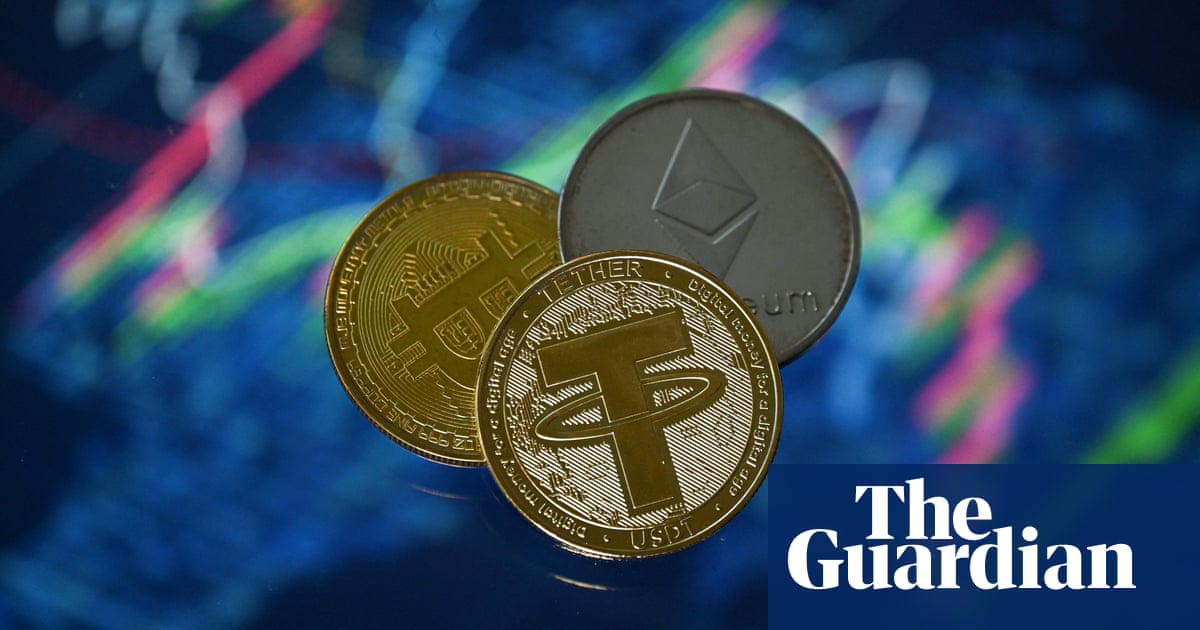Figures suggest company has paid out more than total cash on hand, as terra backers prepare relaunch
Digital investors have withdrawn savings in the “stablecoin” tether worth $7.6bn (£6.2bn) since the cryptocurrency crisis began last week, suggesting the company has paid out a sum almost twice its total cash holdings to spooked depositors.
Stablecoins are supposed to have a fixed value matched to a real-world asset, in most cases $1 a token. However, faith in the concept was rocked last Tuesday when another big player, terra, broke its peg to the dollar. That has fuelled a wider sell-off across the crypto sector, which relies on stablecoins for much of its financial engineering.
A stablecoin, like the name suggests, is a type of cryptocurrency that is supposed to have a stable value, such as US$1 per token. How they achieve that varies: the largest, such as tether and USD Coin, are effectively banks. They hold large reserves in cash, liquid assets, and other investments, and simply use those reserves to maintain a stable price.
Others, known as “algorithmic stablecoins”, attempt to do the same thing but without any reserves. They have been criticised as effectively being backed by Ponzi schemes, since they require continuous inflows of cash to ensure they don’t collapse.
Stablecoins are an important part of the cryptocurrency ecosystem. They provide a safer place for investors to store capital without going through the hassle of cashing out entirely, and allow assets to be denominated in conventional currency, rather than other extremely volatile tokens.
Tether, the third biggest cryptocurrency by “market cap”, experienced a short-lived crisis on Thursday when its value dropped from $1 to 95¢ as savers feared it would follow its fellow stablecoin terra and collapse. However, the token, which is controlled by a private company with close links to the crypto exchange Bitfinex, has since largely restored its dollar peg by honouring a promise to allow savers to always withdraw $1 for every tether they give back to the company.
The company only allows direct withdrawals of at least $100,000 for each request, and charges a fee of 0.1% on redemptions. Anyone with less tether than that minimum can only turn their money into dollars by finding someone to buy it from them – a disparity that fuelled the temporary collapse in value.
Despite the difficulties, according to public blockchain data, $7.6bn of tether has been reallocated in this way since Thursday. That is almost twice the cash that Tether had in its reserves at the end of last year, according to accounts published on its website.
Most of the rest of its reserves are held in “cash-like” assets, the majority of which are $35bn of US government debt and $25bn of corporate bonds. However, the company has refused to share any further details of the investments, with its chief technology officer, Paolo Ardoino, telling the Financial Times: “We don’t want to give our secret sauce.”
There have long been fears as to Tether’s ability to honour all redemptions. The company had once said it backed its currency with “US dollars”, a claim the New York attorney general said in 2021 “was a lie”. Now, it simply claims its currency is “backed 100% by Tether’s reserves”.
By contrast, terra was backed by a complex algorithm that required the value of a sister cryptocurrency, luna, to constantly rise in order to maintain the dollar peg. When the crash hit last week, the system went into a “death spiral”, automatically printing more luna, which crashed the price further, until luna lost 99.9995% of its value in a matter of days and terra was left languishing at $0.11.
The charismatic founder of the Terra project, Do Kwon, has said he wants to relaunch the currency. In a proposal posted to the project’s message board on Friday, he suggested wiping all ownership of luna, and redistributing 1bn new tokens, with most going to those who hold the stablecoin, or who held luna before last week’s crash.
“It is a hard balance – and no easy answers in redistributing value within the network,” Kwon wrote. “But value must be distributed to allow the ecosystem to survive, and in its current state it will not.”
Kwon also faces questions about how the vast sums of bitcoin that his project had amassed to back terra were spent. According to a breakdown shared by the organisation, it sold more than 80,000 bitcoins, worth more than $2.4bn, to unnamed parties in exchange for terra valued at $1 – at a time when the public price of the currency was under 75¢.
The jitters around stablecoins have combined with a general slump in tech stocks and the wider US downturn to trigger a wider crisis of confidence across the crypto sector. Bitcoin and ethereum, the two biggest cryptocurrencies, are down more than 10% over the last seven days, with ethereum dropping 17% to less than $2,000. Smaller currencies have, as always, been more volatile, with dogecoin falling 26% over the week.
Even some of the most vocal backers of digital currencies are now querying the promises of the sector. The founder of the crypto exchange FTX, Sam Bankman-Fried, said in an interview with the Financial Times that bitcoin has no future as a payments network because of the inherent inefficiencies of its blockchain, the public digital register that records its transactions. Instead, he argued, it could only function as a gold-like store of long-term value.

